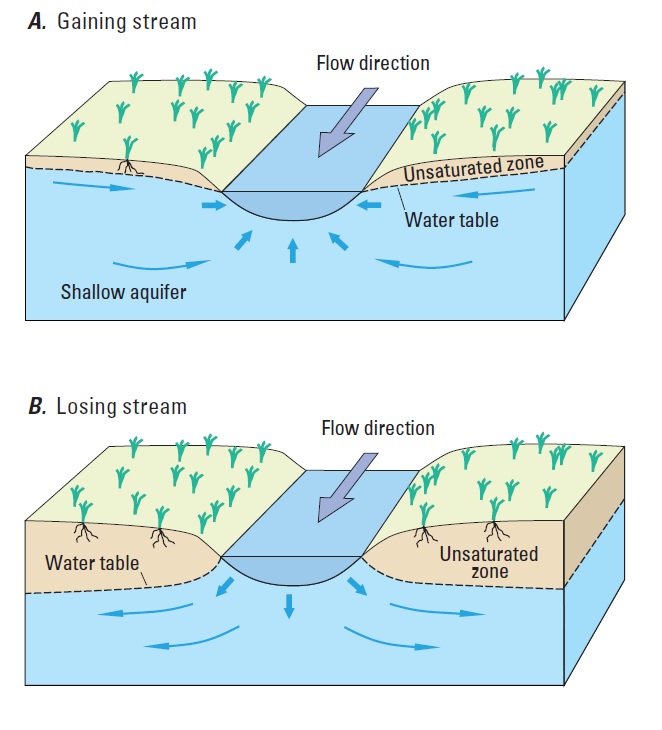The INOWAS platform helps to assess streamflow depletion and the application of MAR to sustain environmental river flows.
Groundwater and surface waters are connected and groundwater discharge is often an essential part of stream flow (Barlow and Leake, 2012). Depending on the surface-water-groundwater interaction in a stream reach, groundwater discharges into streams (gaining) or stream water percolates into the aquifer (losing) (Figure 1).

Figure 1. Possible connections of surface water and groundwater. A) shows a gaining stream reach where groundwater discharges into the stream, B) illustrates a losing stream reach where stream water discharges into the aquifer (Barlow and Leake, 2012). If the stream is underlain by an unsaturated zone, the stream also loses water but is said to be disconnected from the underlying aquifer.
The water flow rate depends on the hydraulic gradient between the aquifer and the stream and on the streambed hydraulic conductivity. Groundwater pumping can lower the water table and therefore less water discharges into the streams respectively more river water percolates into the aquifer. As a consequence, streamflow is reduced which can have negative impacts on the aquatic ecosystem, the availability of surface water as well as the river water quality (Barlow and Leake, 2012). As a mitigation method, MAR can be used to store excess water and increase the groundwater discharge and as a consequence augment reduced stream flows (Barlow and Leake, 2012). Numerical modeling has already been used to optimize and plan MAR schemes as well as to analyse the impact on the resulting stream discharge. A regional MODFLOW model was for example used to assess the augmentation potential of low stream flows during the summer months in nothwestern USA (Barber et al., 2009). Artificial recharge was simulated using lake water during winter periods when flows are high and excess water is available. Results show that the aquifer could be successfully used to improve low-flow season stream discharge by implementing infiltration basins or wells. Lacher et al., 2014 also used MODFLOW for predictive simulations in the San Pedro River catchment, a transboundary river crossing Mexico and Arizona, USA. The simulations indicate that streamflow restoration due to MAR is feasible and river baseflow could be sustained.
The following INOWAS tools provide a basis for the assessment of streamflow depletion and the implementation of MAR as a mitigation method:
- T03. MODFLOW model setup and editor
- T07. MODFLOW model scenario manager
- T14. Pumping-Induced River Drawdown
To select a suitable MAR method or a model set for the specific study area, the following tools can be used:
REFERENCES
- Barber, M.E., Hossain, A., Covert, J.J., Gregory, G.J., 2009. Augmentation of seasonal low stream flows by artificial recharge in the Spokane Valley-Rathdrum Prairie aquifer of Idaho and Washington, USA. Hydrogeology Journal 17, 1459–1470. doi:10.1007/s10040-009-0467-6
- Barlow, P.M., and Leake, S.A., 2012, Streamflow depletion by wells—Understanding and managing the effects of groundwater pumping on streamflow: U.S. Geological Survey Circular 1376, 84 p. (Also available at https://pubs.usgs.gov/circ/1376/.)
- Lacher, L., Turner, D., Gungle, B., Bushman, B., Richter, H., 2014. Application of Hydrologic Tools and Monitoring to Support Managed Aquifer Recharge Decision Making in the Upper San Pedro River, Arizona, USA. Water 6, 3495–3527. doi:10.3390/w6113495
